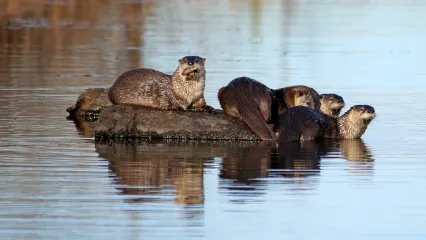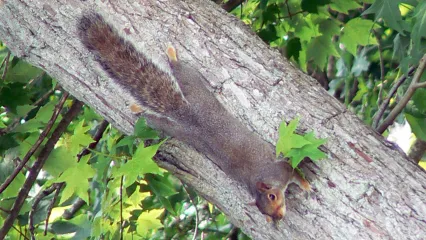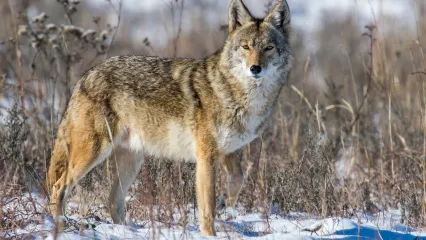
Description
One of the most energetic North American species, the river otter, Lutra canadensis, loves water and land equally. This playful, lively animal enjoys diving into water, sliding across mud and ice, and socializing with other otters. River otters are slender, dark brown mammals with gold highlighting their face and chest. Based on their name, it's no surprise these creatures live near rivers, ponds and other bodies of water across North America.
River otters are perfectly suited for swimming. With small heads and high-set eyes, river otters have flexible spines that allow them to travel through the water in beam-like positions. As an otter goes for a swim, its blood flow slows drastically and cuts circulation to the outermost extremities. The little circulation that remains goes back and forth between the brain and the heart, which allows the otter co stay underwater for longer periods. The river otter's nostrils and ears close when it is submerged. It also has an unusually thick, waterproof coat that keeps water away from the skin. Otters do not rely on fat to keep them warm; they have thick fur that does the job.
River otters are big enough that few predators will attempt to attack them, which makes it easier for the otters to enjoy swimming and diving in the water. Occasionally a bobcat, coyote or larger animal will be able to catch one. A predator itself, the river otter preys on fish, frogs, turtles, crayfish, and sometimes the eggs of ground-nesting birds. They'll eat most any species of fish, such as carp and sunfish, but smaller fish are the easiest meals.
Size
Standing a little under a foot tall at the shoulders with tails as long as 3 feet, the river otter can be up to 4 feet long and weigh between 15 and 20 pounds.
Habitat
River otters prefer to be away from civilization. Some otters even have a 20-mile range all to themselves, but they often find other river otters to socialize with. If a beaver is present in an area, it is common that river otters are there as well. River otters are known to use beaver dens as their own for shelter and protection.
Life Cycle
Mating season occurs in spring for river otters. They travel long distances and use a variety of noises to communicate with each other. Almost a year later, females give birth to two or three offspring, usually in another animal's abandoned den. River otters are born helpless. After learning to swim, the young will begin to travel and hunt their own food. At age 2, the otters will produce their own litters. River otters can live 15-20 years.
How To Observe
You might spot one of these "water weasels" near a pond or river. However, you may not spot one again in the same area for a while, as they travel frequently and do not stay in one spot for long.
Sportsmen can pursue these animals through hunting and trapping. Refer to the current "Oklahoma Hunting and Fishing Regulations Guide" for harvest details.


